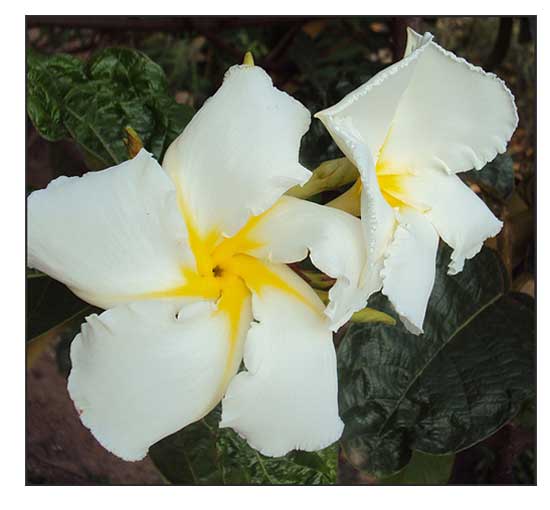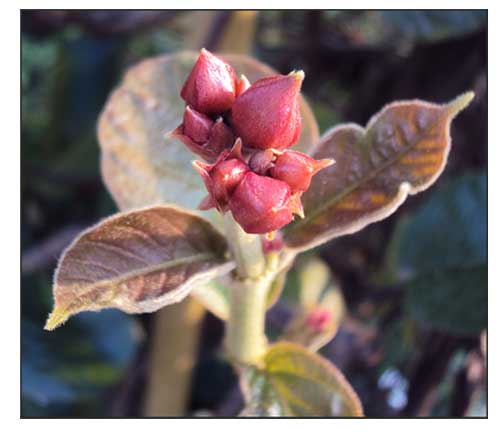 Gen info Gen info
- Chonemorpha is a genus of large evergreen vigorous woody vines with milky sap. They grown dormant in sub-tropical and tropical climates, usually losing leaves when the temperature gets below 60°F.
-
Chonemorpha fragrans, the frangipani vine or climbing frangipani, is a plant species in the genus Chonemorpha.
- Etymology: The genus name Chonemorpha derives from Greek words chone,meaning "funnel: and morphe meaning "form", referring to the shape of the corolla. The specific epithet fragrans refers to the fragrant flowers. (4)
Botany
• Growth form: A latex-containing climber or liana up to 20 m long, its branchlets are sparsely to densely covered with hair, and lenticillate. Foliage: Latex-containing, opposite, stalked leaves have leathery leaf blades that are round, oval or drop-shaped with a rounded or pointed tip and a heart-shaped to narrowed base, 4–38 by 2.8–35 cm, and densely covered with hair. Flowers: Fragrant, tubular flowers are cream or white, 1.8–6.5 by 4.2–13 cm, hairless or hairy, and are arranged in many-flowered, 10–30 cm long clusters at the ends of branches. Fruit: Fruits are spindle-shaped, flattened, hairless or hairy, and 18–40 by 1–2.3 cm. (Flora & Fauna Web)
 • Chonemorpha fragrans is a vigorous climber, reaching up to 30 m (98 ft). It can also grow or spread to about 7 m (23 ft) wide, depending on the support. It has a rusty brown or gray barked stem which is numerously lenticelled. Bark can produce fibre of good quality. It is evergreen in most tropical climates. Elsewhere, in the spring, the fresh new leaves are bright green with a bronze hue. Mature leaves are large, deep green, shiny, and hairy, especially underneath; broadly ovate, orbicular, or elliptic in shape, with a 2 cm long, 15–45 cm (6–18 in) wide and 13–45 cm (5–18 in) long, with 10-12 pairs of lateral, prominent veins. It has terminal (end of stem) clusters of blooms, highly fragrant, with tubular sepals, which are 1 cm long, with a white corolla, which is 8–10 cm (3–4 in) long, with a yellow, hairy throat. After blooming, it produces a a lanceolate or oblong seedcase, inside which are flat seeds, shortly beaked with long white silky coma. All parts of the plant produce a milk-like substance when damaged. (14) • Chonemorpha fragrans is a vigorous climber, reaching up to 30 m (98 ft). It can also grow or spread to about 7 m (23 ft) wide, depending on the support. It has a rusty brown or gray barked stem which is numerously lenticelled. Bark can produce fibre of good quality. It is evergreen in most tropical climates. Elsewhere, in the spring, the fresh new leaves are bright green with a bronze hue. Mature leaves are large, deep green, shiny, and hairy, especially underneath; broadly ovate, orbicular, or elliptic in shape, with a 2 cm long, 15–45 cm (6–18 in) wide and 13–45 cm (5–18 in) long, with 10-12 pairs of lateral, prominent veins. It has terminal (end of stem) clusters of blooms, highly fragrant, with tubular sepals, which are 1 cm long, with a white corolla, which is 8–10 cm (3–4 in) long, with a yellow, hairy throat. After blooming, it produces a a lanceolate or oblong seedcase, inside which are flat seeds, shortly beaked with long white silky coma. All parts of the plant produce a milk-like substance when damaged. (14)
Distribution
- Native to the Philippines. (1) (2)
- In Luzon: Abra,
Batangas, Laguna, Mountain Province, Nueva Ecija, Rizal; Palawan.
- In low elevation forests.
- Also native to Andaman Is., Assam, Bangladesh, Borneo, Cambodia, China South-Central, China Southeast, East Himalaya, India, Jawa, Laos, Lesser Sunda Is., Malaya, Myanmar, Nepal, Sri Lanka, Sulawesi, Sumatera, Thailand, Tibet, Vietnam, West Himalaya. (1)
 Constituents Constituents
- Phytochemical screening of alcoholic extract of root powder yielded sterols, glycosides, saponins, proteins, tannins, alkaloids, and carbohydrates, with absence of triterpenoids and flavonoids. Water extract yielded glycosides, saponins, proteins, tannins, carbohydrates, triterpenoids, and flavonoids, with absence of sterols and alkaloids. (8)
- Study of acetone extract of roots yielded 9 non-alkaloid constituents viz., sitostenone (1), β-sitosterol (2), naringenin (3), aromadendrin (4), matairesinol (5), vanillic acid (6), ferulic acid (7), protocatechuic acid (8) and sitosterol-3-O-β-D-glucopyranoside (9), while ethanol extract yielded five alkaloidsjapindine (10), sarcorucinine D (11), dictyophlebin (12), chonemorphine (13) and N-formylchonemorphine (14). (see study below) (9)
- Phytochemical screening of ethanolic root extract yielded carbohydrates, proteins and amino acids, alkaloids, glycosides, flavonoids, saponins, phenolic acids and tannins, with absence of phytosterols and triterpenoids. (see study below) (13)
- Phytochemical screening revealed flavonoids, glycosides, alkaloids, gums, mucilage, phytosterols, and saponins.
(see study below) (15)
- GC-MS study of flowers for essential oil
identified 221 compounds. Major compounds were 2, 3-epoxy-2, 3- dihydrosqualene (27.92%), squalene (18.76%) and 1, 2- benzenediol (20.92%) from fresh flower volatiles. Dried flower volatiles were predominantly β-sitosterol (43.91%), sitostenone (15.09%), and methyl commate D (8.29%). (18)
Properties
- All plant parts produced a milk-like substance when damaged.
- Roots are sweet, bitter, astringent, laxative, thermogenic, depurative, carminative, anthelmintic, digestive, antiscorbutic, anodyne, expectorant and febrifuge. (5)
- Caution: The bark and leaves are poisonous.
- Studies have suggested anticancer, enzyme inhibitory, antimicrobial, antioxidant, DNA protective, hepatoprotective, anti-glycation, xanthine oxidase inhibitory, antiamoebic, α-amylase inhibitory, antidiabetic properties.
Parts used
Entire plant, leaves, roots, stems.
 Uses Uses
Edibility
- No reports found on edibility.
Folkloric
- No reported folkloric medicinal use in the Philippines. (2)
- Mentioned in almost all ancient ayurvedic tests for its extraordinary medicinal properties, which categorize it as carminative, anthelmintic, and digestive. While alleviating kapha and vata, it aggravates pitta.
- In Indian medicinal systems used for treatment of skeletal and gynecological disorders, stomach disorders, rheumatism, skin disease, diabetes, and jaundice.
- In traditional Tamil villages, the bitter decoction of C. fragrans roots is mixed with tamarind and jaggery to relieve chronic constipation and neurological cramps. (11)
- Tribal healers in Myanmar use fresh leaf juice as external wash for insect bites.
(11)
- In Kerala, root decoction infused with coconut oil used for "sleep massage", with the belief that the plant's scent soothes the mind. (11)
- Decoction of crushed roots, which are sweet and bitter, drunk to facilitate expulsion of the placenta and to treat amebic dysentery. Stem of plant used for treatment of fractures and rheumalgia. (3)
- Entire plant, roots, and root bark used for fever and stomach disorders. Plant used for treatment of skin diseases and inflammations. (5)
Others
- Fiber: Plant is sometimes cultivated for the fiber obtained from the stem, which is used for making fishing nets, especially in East Java. (3)
- Latex: Latex can be source of rubber.
- Landscape: Widely grown as a fence cover or for pergolas.
- Cultural: Malay women wear the sweet-scented flowers in their hair.
Studies
• Cytotoxicity / Anticancer / Enzyme Inhibitory: Study evaluated and compared the cytotoxicity of sequential and crude extracts of in vivo plant parts (leaves, bark, and roots), in vivo cultures, and callus. MTT assay showed the chloroform extract of callus showed potent anticancer potential against human colon epithelium, lung carcinoma and epidermoidal carcinoma cells lines. It was also shown to possess Topo as well as DNA polymerase inhibitory activity. (5) (7)
• Antimicrobial / Anticancer / Leaves and Callus: Methanolic extract exhibited excellent broad-spectrum antimicrobial activity against Klebsiella pneumonia, Staphylococcus aureus, Pseudomonas aeruginosa, and Bacillus subtilis, more than aqueous extracts of leaves and callus. Methanolic extract of leaves exhibited anticancer activity with inhibition of leukemic cells with IC50 of 0.3 and 0.29 µg/ml in HL-60 and K562 cells, more than the aqueous extract of callus and leaves. (6)
• Sarcorucinine D / Antibacterial / Roots: Study of ethanol extract of C. fragrans roots isolated 9 non-alkaloid and 5 alkaloid constituents. Compound 11, the alkaloid sarcorucinine D, showed most promising antibacterial activity. (see constituents above) (9)
• Antioxidant / DNA Protective: Study evaluated the antioxidant potential and DNA protection ability of C. fragrans. Extracts showed significant antioxidant potential. The phenol content showing high correlation with Phosphomolybdenum reduction potential, while the flavonoid content correlated with Phosphomolybdenum as well as H2O2 radical scavenging potential. All extracts showed ability to protect DNA against devastating effects of Fenton's reagent except methanol roots, stem bark, in vitro and callus extracts. (10)
• Influence of Elicitors on Camptothecin Accumulation and Antioxidant Potential / Callus Culture: (Camptothecin (CPT) is a well known anticancer drug used for treatment of various types of cancer.) Study evaluated the role of elicitors viz., chitosan, salicylic acid, yeast extract and glycine on biomass, camptothecin production and antioxidant capacity of callus culture. Antioxidant and secondary metabolites were higher in the Ct elicited callus. GC-MS analysis revealed presence of phyto-constituents like ß-sitosterol, stigmasterol, and squalene. Higher camptothecin (CPT) was noted in Ye supplemented callus. Results showed elicitor supplements have potential to enhance biomass and phytoconstitu3ents in leaf-derived callus cultures of C. fragrans. (12)
• Hepatoprotective / Paracetamol and INH-Induced Toxicity / Root: Study evaluated the hepato-protective activity of alcoholic extract of C. fragrans root in Sprague-Dawley rats against paracetamol and isonizid models of liver toxicity. C. fragrans and silymarin administration prevented the toxic effect of paracetamol and isonizid on biochemical parameters. Results showed hepatoprotective activity which may be attributable to antioxidant potential against DPPH, hydroxyl and superoxide radicals. The hepatoprotective role of the extract at 400 mg/kg was found comparable to Silymarin, which may be due to the presence of flavonoid. (13)
• Antimicrobial / Leaves: Study evaluated the antimicrobial effects of ethanolic leaf extracts of C. fragrans against four human pathogenic bacteria viz., B. subtilis, S. aureus, E. coli, and P, aeruginosa using agar well diffusion method, MC and MBC. Results showed significant activity against all pathogens which showed maximum zone of inhibition and minimum MICs against all strains. (see constituents above) (15)
• MgZnO Nanoparticles / Leaves: Study reports on the synthesis of MgxZn1-xO (x = 0, 0.25, 0.5, 0.75 and 1) NPs using leaf extract assisted solution combustion method. Results suggest the synthesized NPs are promising candidates for wastewater treatment and lead sensor applications. (16)
• Antioxidant / Anti-Glycation / Xanthine Oxidase / Leaves: Study evaluated leaf extracts of C. fragrans and Ellertonia rheedii for antioxidant and anti-glycation activities. The EtOH extract of C. fragrans at 100 µg/ml showed maximum activity of 65.83%. Both showed excellent H2O2 scavenging, NO scavenging, and xanthine oxidase inhibition. Extracts from both plants also exhibited excellent anti-glycation activity, with C. fragrans 87.66%. inhibition of AGEs. Results suggest a bio-friendly natural source of phytoconstituents that may serve as substitute for conventional synthetic compounds. (17)
• Anti-amoebic Activity / Steroidal Alkaloid Chonemorphine: Chonemorphine, a steroidal alkaloid isolated from C. fragrans was identified as an antiamoebic principle during a screening program for novel antiparasitic agents from plant sources. Dose of 100 mg/kg x 4 chonemorphine led to a 100% cure of experimental hepatic infection in golden hamsters and cleared 90% of intestinal infection in weanling Wistar rats at 200 mg/g x4. The discovery adds to list of few plant amoebicides such as emetine and conessine. (19)
• α-Amylase Inhibitory Activity / Antioxidant / Root: Study evaluated the invitro α-amylase inhibitory activity and antioxidant potential of total ethanolic and various fractions of root of C. fragrans. The chloroform and ethyl acetate extracts showed appreciable α-amylase inhibitory activity with IC50s of 42.5 and 47.5 µg/ml respectively, compared to standard acarbose with IC50 of 25 µg/ml. Strong antioxidant properties were shown with DPPH, ABTS, ferric reduction, nitric oxide, and total antioxidant models. (20)
• Antihyperglycemic / Hypoglycemic / Roots: Study evaluated an alcoholic of C. fragrans root extract administered orally at doses of 100 and 200 mg/kg in normal, glucose-loaded, and alloxan-induced diabetic rats. Single dose of 200 mg/kg orally produced significant reduction of blood glucose in fasted normal rat, glucose over loaded rats, and alloxan-induced diabetic rats. Histopathological study on pancreas of alloxan-induced diabetic rats detected inflammatory changes in the pancreatic islets from selective destruction of insulin-producing ß-cells. The changes were dose-dependently inhibited by the extract and glicazide. (21)
Availability
- Wild-crafted.
- Cultivated. |

![]()







